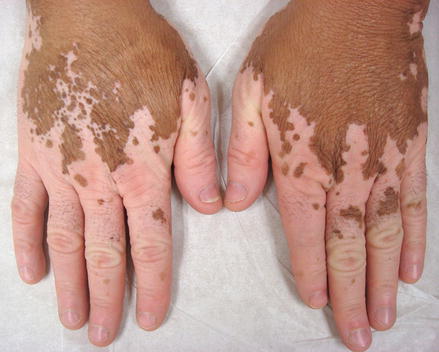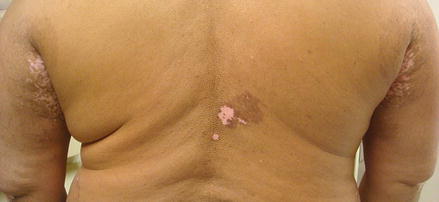Figure 16.1
Depigmented patches on the cutaneous lips and periorificial skin

Figure 16.2
Depigmented patches on the bilateral dorsal hands

Figure 16.3
Depigmented patches on the mid-back and bilateral axilla with evidence of repigmentation
Clinical Differential Diagnosis
Based on the clinical findings, vitiligo was felt to be the most likely diagnosis. The differential diagnosis also included chemical leukoderma (occupational/exposure related), leukoderma associated with scleroderma, piebaldism, and post-inflammatory hypopigmentation. Depending on the distribution and the percentage of body surface area involved, the differential diagnosis for vitiligo can also include nevus anemicus, nevus depigmentosus, infections (such as tinea versicolor, leprosy, onchocerciasis), leukoderma associated with melanoma, idiopathic guttate hypomelanosis, and hypopigmented mycosis fungoides (Alikhan et al. 2011; Taieb and Picardo 2009).
Histopathology
Vitiligo is often a clinical diagnosis; however, in difficult cases, histopathology can help differentiate vitiligo from other pigmentary disorders. Biopsy of a vitiligo lesion typically reveals few or no melanocytes and loss of melanin pigment within the epidermis. In chronic, stable lesions, the rest of the skin typically appears intact and unremarkable. However, degenerative changes in cutaneous nerves and adnexal structures in chronic lesions have been reported. In contrast, a lymphocytic lichenoid inflammatory infiltrate may be seen at the margins of newer lesions (Alikhan et al. 2011; Taieb and Picardo 2009).
Diagnosis
Vitiligo
Case Treatment
The nature and course of vitiligo was reviewed with the patient. Treatment options were discussed, including observation, topical corticosteroids, topical calcineurin inhibitors, and/or phototherapy. The patient opted for a combination of topical corticosteroids and narrowband ultraviolet B (NB-UVB) phototherapy. Triamcinolone 0.1 % ointment twice daily was prescribed for a 2-month course to his hands and fingers in a pulsed fashion. In addition, NB-UVB phototherapy three times weekly was initiated. A serum thyroid-stimulating hormone (TSH) was sent to screen for thyroid disease, which was within normal limits.
Discussion
Vitiligo is an acquired pigmentary skin disorder that affects individuals of all races and ethnicities. It is characterized by asymptomatic, well-demarcated, depigmented macules or patches that are surrounded by normal skin. The natural progression of the disease varies, ranging from insidious to rapid onset. It occurs in males and females equally and typically first presents between 10 and 30 years of age (Alikhan et al. 2011; Taieb and Picardo 2009).
Vitiligo affects nearly 0.5–1 % of the world population; however, prevalence varies based on region. The highest reported prevalence is in Gujarat, India, where the disease affects up to 8.8 % of the population. One study in the French West Indies concluded that the disease prevalence in the black population is the same as or slightly less than in the white population (Alikhan et al. 2011). Overall, reporting rates likely vary greatly based on social stigma and the more obvious nature of disease in skin of color.
Diagnosis is usually made clinically. Use of a Wood’s lamp, which is a handheld ultraviolet A (UVA) emitting device, can aid in diagnosis. The classic depigmented lesions of vitiligo give a white fluorescence and tend to be more pronounced under illumination compared to hypopigmented lesions (Alikhan et al. 2011; Taieb and Picardo 2009).
There are three main types of vitiligo: localized, generalized, and universal. Generalized vitiligo is the most common type, which is further subtyped into acrofacial, vulgaris, or mixed. Localized vitiligo can be focal, segmental, or mucosal in nature. Universal vitiligo involves more than 80 % of the body surface area. While any part of the body can be affected, initial lesions are most frequently found on the dorsal surface of hands, forearms, feet, face, and around facial orifices (eyes, nose, mouth). There are several clinical variants including: vitiligo ponctué, trichrome vitiligo, quadrichrome vitiligo, blue vitiligo, and inflammatory vitiligo. Quadrichrome vitiligo, which is defined by a tan zone between normal and depigmented skin and marginal or perifollicular hyperpigmentation, is more common in darker skin types (Alikhan et al. 2011).
Stay updated, free articles. Join our Telegram channel

Full access? Get Clinical Tree








